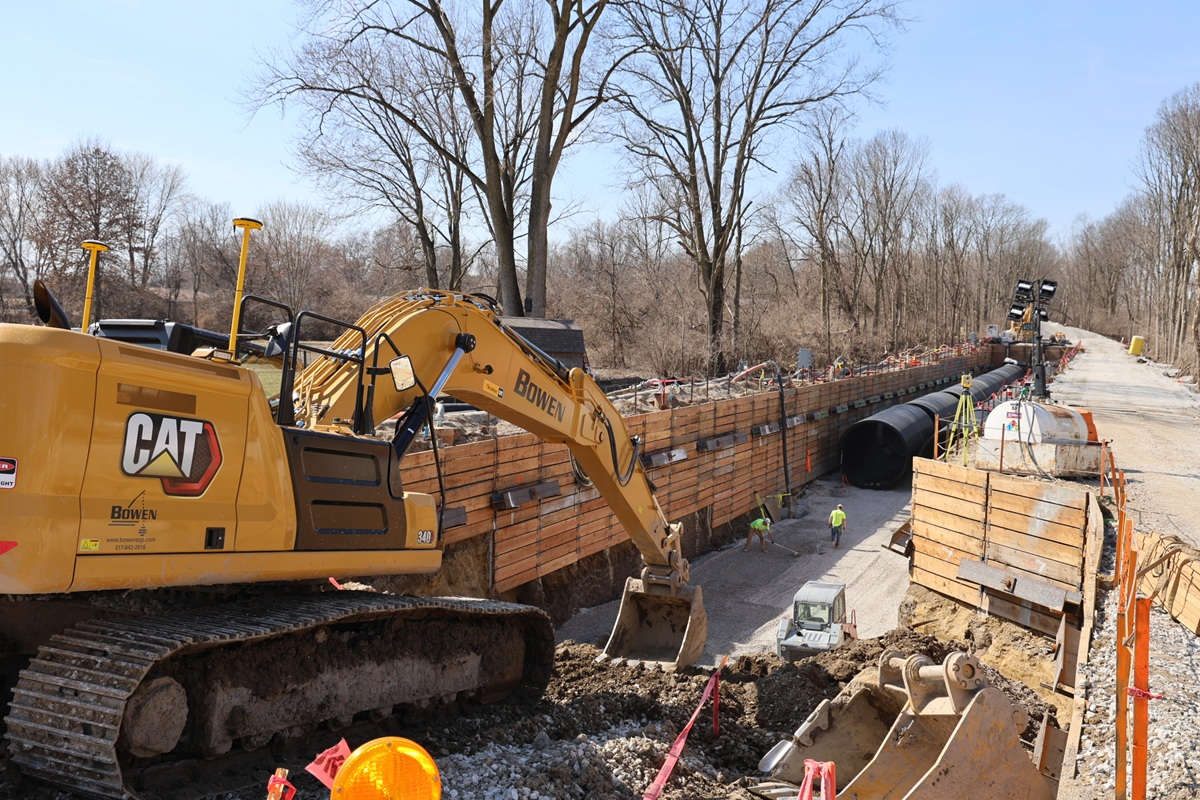Surviving In Scarcity

These events serve as an example of the situation facing much of the utility industry. There is a flood of work to be completed while resources of all types are scarce.

This 2014 Utility Outlook investigates the spending, scarcity and opportunity in the Electric and Gas Transmission and Distribution; Water, Waste Water and Sewer; and Communication sectors. Successful contractors will recognize that this situation demands innovative solutions to thrive in an environment of scarcity. Said another way, there is “Water, water, everywhere, Nor any drop to drink.”
Transmission and Distribution (T&D) — Electric and Gas Spending Forecast
The T&D segment in total weathered the financial crisis relatively unscathed, supported by strong spending on gas or liquid pipelines. The electric sector is not as healthy, as 2012 and 2013 have seen rapid pipeline spending growth fueled by economic, government, tax and interest rate incentives that overpowered the underlying slow economic growth obstacles. In addition, low natural gas prices have allowed gas distribution utilities to undertake large infrastructure replacement projects with users seeing very little effect on their bills. Gas prices have bottomed and will slowly rise, changing this dynamic.
Moving forward, a slowing of the growth rate from 2012 and 2013 is forecasted (Exhibit 1). A brief and shallow economic slowdown is forecasted in late 2014 or early 2015, as is weak electric power demand, increasing utility bills and the slow rise in natural gas prices. All of which will combine to temper the enthusiasm for additional infrastructure replacement projects. By 2016, an improving economy, housing market and a gradual increase in electric demand will accelerate spending on both pipelines and electric lines. Growth is forecasted to slow in 2017 by which point we will have experienced over a decade of spending growth within this sector moving from approximately $20 billion in 2004 to $80 billion in 2017. A combination of rising interest rates and wage pressures will yield inflation, which will slow spending as the first wave of large programs and projects near completion and ratepayer/PUC fatigue limits the size and scope of new programs.
T&D Abundance vs. Scarcity
The disparity between abundance and scarcity is the difference between the gas and electric markets.
The positive economic and safety aspects of natural gas exploration, production, gathering and T&D are so powerful as to drive construction activity in both the pipeline and electric line sector. On the electric side, the lower cost to produce power by burning natural gas yields savings to electric utility customers and creates some breathing room for growth in electric T&D construction activity. However, hurdles still exist.
Labor scarcity, particularly for the capital construction and O&M workforce within gas and electric utilities, will prove a high hurdle. Twenty four percent and 25 percent of the electric T&D and gas T&D workforce are over the age of 55. Most of the Northern United States, Northeast and the Mountain West have a particularly old workforce.2

Funding the needed spending on electric infrastructure in the absence of demand increases will fall on ratepayers at higher levels than in the past. Pushing needed rate increases through utility commissions will prove more difficult as rates have been rising above the rate of inflation since 2005.4 For a family earning $50,000 per year in 2001, electricity consumed 2.8 percent of after tax income. By 2012, this same family would spend 3.9 percent of its income on electric power. 5
There is regional variation to this challenge that is counterintuitive. States that have the lowest power cost may have the most difficulty raising rates. In traditional low cost states that rely on coal for electric generation (South, Midwest and Mountain West), power prices have been increasing as regulation has resulted in significant spending or the shuttering of coal plants. These areas, such as West Virginia, have seen the largest cost increase and are already under rate pressure due to increased generation cost. Efforts to obtain funding for T&D projects will be competing with these spending priorities. The Northeast, which relies primarily on natural gas, is seeing falling power prices. This creates an opportunity for utilities in these markets to invest in infrastructure improvement with less impact on ratepayers.
Gas pipelines face different challenges. The cost decline of natural gas, along with very little demand for new construction related to housing growth, have allowed utilities to invest in infrastructure replacement while the consumers’ gas bill remained flat or even declined. This trend is unlikely to continue, meaning that future expansions will require additional monies from ratepayers. Current accelerated infrastructure replacement programs won’t be threatened, but future programs are likely to be less robust in scope and scale.
Water Supply, Sewage and Waste Disposal Spending Forecast
Three of the last four years have seen reductions in total spending on water supply, sewage and waste disposal construction. Funding is the issue in this segment and weakened state/municipal budgets only increase this long-term challenge. Beyond 2015, improving economic conditions will lead to some spending growth and acceleration in 2016 and 2017. Fueling this growth are improving economic conditions, housing starts and neglected infrastructure since 2009.
Water, Wastewater and Sewer Abundance vs. Scarcity
The disparity between abundance and scarcity is the most pronounced within the water supply, sewage and waste disposal sector.
The abundance of water demand and usage belies a host of scarcities that in the end come back to the difficult funding environment. Specifically, alternative funding approaches, user rate increases and a combination of courage and leadership to address hiring and training are in short supply.
The needs are staggering. The American Society of Civil Engineers rates the nation’s drinking and wastewater systems a D. The overall investment needed for fresh water over the next 20 years is $312 billion. Of the $312 billion needed, 59 percent is transmission and distribution, 20 percent is treatment systems and 11 percent is storage. Wastewater needs $298 billion in investment over the same 20-year period where 63 percent is wastewater treatment, pipe repairs and new pipe, 21 percent to correct combined sewer outflows and the remaining 14 percent is for storm water management.6 The American Water Works Association estimates spending will need to grow from its current $13 billion annually to $30 billion by the 2040’s (in 2010 dollars), nearly a three-times increase.

Currently, the bulk of spending on fresh water, 98 percent, is coming from local and state government with the federal government accounting for only about 2 percent of total spending. State and local budgets are only now beginning to recover from the financial crisis, limiting the potential for increased funding in the short-term. Federal appropriations for wastewater fell on an annual basis between 2008 and 2012.

Assuming the funding or rate increases could be had, the challenges of doing the work are also significant. Overall, 23.4 percent of the Water/Wastewater workforce is over 55. Regionally, the workforce age differences are significant with the North and Northeast consisting of a significantly older workforce … in excess of 40 percent of their workforce over age 55.7
Communication Spending Forecast
The last peak in communications spending was 2007/2008 with only modest recovery. The underlying demand for data centers and wireless to wired bandwidth expansion have continued to support construction spending but the current wave of spending, particularly around 4G infrastructure, is concluding. Nationally, we forecast little improvement in overall construction spending until 2015/2016 (Exhibit 6).

The absence of any new revolutionary technology, particularly in the mobile network space, results in spending growth driven by incremental capacity improvements.
Communication Abundance vs. Scarcity
Within the communication construction segment, there are areas of abundance in juxtaposition vs. scarcity.
The abundance of spending and rapid rollout of 4G LTE networks is supporting construction service providers operating in the wireless space. Unfortunately, this phase of the wireless revolution is coming to an end.
Verizon’s rollout is essentially complete with 4G now covering 99 percent of its legacy 3G footprint.8
AT&T will complete its initial 4G efforts in late 2014 though most major markets are already complete.9
Sprint plans to cover 200 million Americans by the end of 2013, well short of Verizon’s 300 million. Sprint will likely be building out its 4G network into 2015.10
T-mobile was the last to begin rollout of a 4G network though implementation is moving fast. In one year, the network grew to cover 157 million people and is well ahead of schedule.11
As 4G networks are completed, the industry is now ahead of the next wave of technology for the first time in its history. While investment in networks will not stop, focus will shift to providing additional capacity. The smartphone market is also approaching maturity, with 56 percent of U.S. cellphone owners on smart platforms as of May 2013. This is a 20 percent increase from May 2011.12
Relative to the rest of the utility industry, the communications workforce is relatively young. Only 12 percent of telecommunications line installers are over 55, while 19 percent of equipment installers are over 55.13 With some skills that are applicable in the electric distribution and gas distribution market space, the relatively modest growth of spending in this segment over the next two years offers opportunity to apply a younger workforce in the broader utility industry.
Moving forward, communication industry participants will need to adapt to a market shifting from massive efforts to build new networks to one which is focused on incremental improvement through 2020. Contractors should monitor progress on 5G technologies to identify niche tech, which will drive spending and prepare for the next wave of network construction in the next decade.
Overall Conclusions
The mariner ultimately survives the scarcity he is subject to by making use of the sea creatures swimming in the water surrounding him. In the utility construction space, embracing the environment we are faced with as one filled with the promise and opportunity will yield the same outcome — survival. For successful contractors, merely surviving is not enough; they seek innovative solutions to thrive in an environment of scarcity.
Utility capital asset owners, facility operators and utility construction service providers who pick the right markets, build their skills and embrace scarcity for the opportunities it presents can thrive in the face of scarcity and set sail for success in 2014 and beyond.
Mark Bridgers and Nate Scott are consultants with Continuum Advisory Group, which provides management consulting, training and investment banking services to the worldwide utility and infrastructure construction industry. They can be reached at 919.345.0403 or MBridgers@ContinuumAG.com and followed on Twitter at @MarkBridgers. For more information on Continuum, visit www.ContinuumAG.com.
1 The dedicated professionals at the local Colorado utilities deserve recognition for their response to this disaster. The staff at my local water utility, Left Hand Water District in Niwot, Colo., did an excellent job restoring service and getting the boil water order lifted. In a matter of days they had the system up and running despite large sections of main being destroyed all while access to their offices and facilities was cut off by flood waters.
2 “Current Population Survey” Bureau of Labor Statistics.
3 “Annual Energy Outlook 2013, Market Trends – Electricity” U.S. Energy Information Administration, April 15, 2013.
4 “Electric Power Monthly” U.S. Energy Information Administration, September 30, 2013.
5 “Energy Cost Impacts on American Families” American Coalition for Clean Coal Electricity, February 2012.
6 “2013 Report Card for Americas Infrastructure,” American Society of Civil Engineers (ASCE), March 2013.
7 “Current Population Survey,” Bureau of Labor Statistics.
8 Kameka, Andrew. “Verizon 4G LTE network reaches its 500th market and covers 99 percent of 3G footprint”, June 27, 2013.
9 AT&T, “About Our Network”, 2013.
10 Cheng, Roger. “Why Sprint is taking its sweet time with 4G LTE,” CNET, July 24, 2013.
11 Freml, John. “T-Mobile shows Sprint how a proper LTE rollout is done” Pocketables, July 11, 2013.
12 Bostic, Kevin. “Smartphones now account for 56% of US market, Apple’s iPhone at 25% share” Apple Insider, September 9, 2013.
13 Bureau of Labor Statistics, 2012 employment data.





